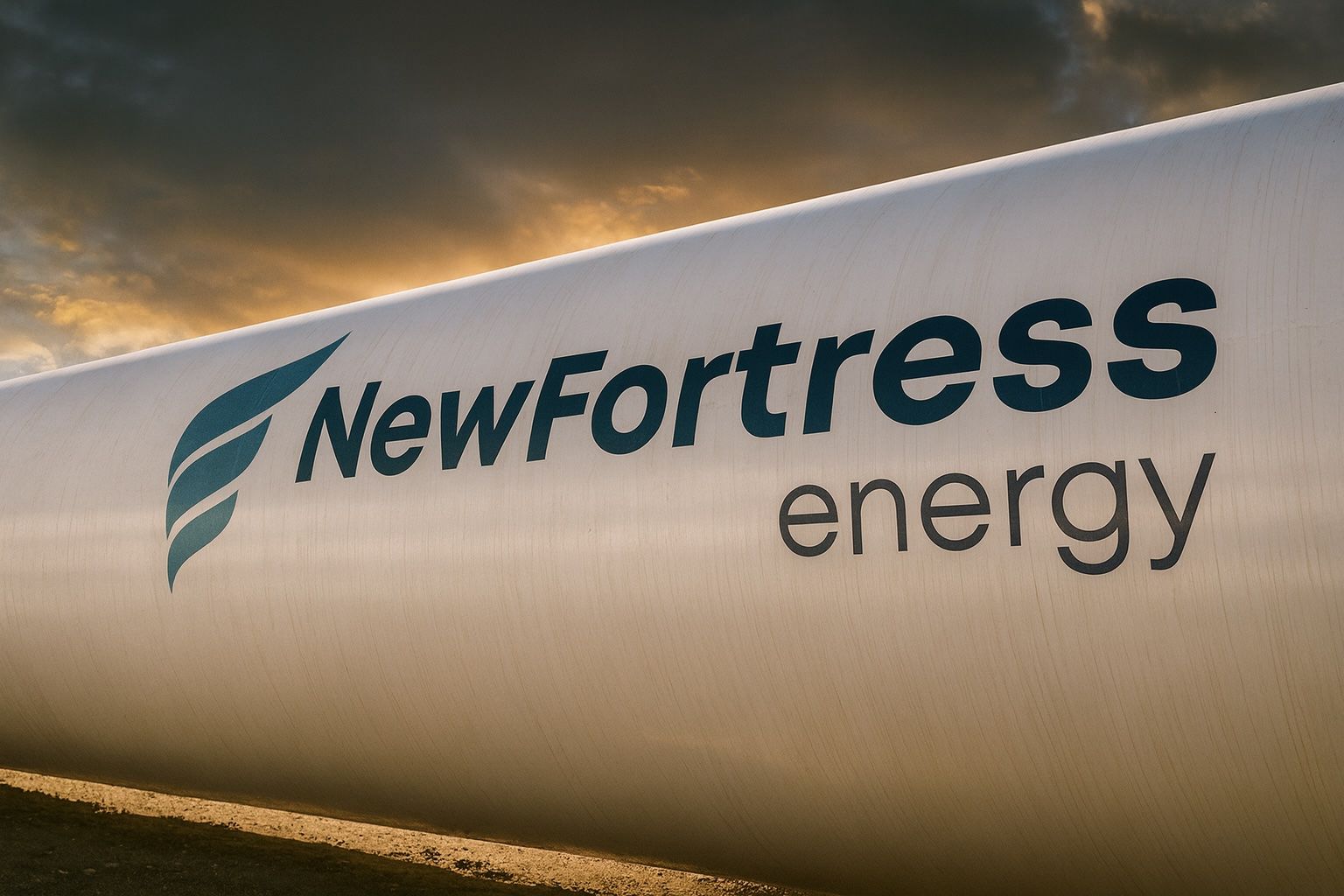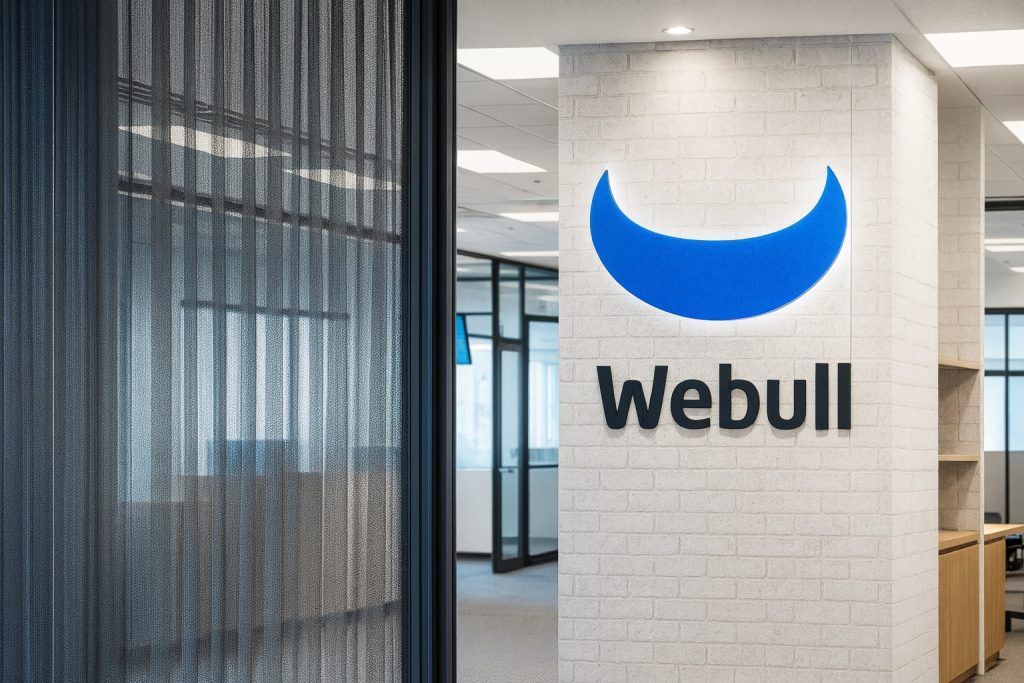Published: November 20, 2025
New Fortress Energy Inc. (NASDAQ: NFE) is back in the spotlight today after Fitch Ratings slashed the company’s long‑term credit rating to “RD – Restricted Default” following a missed interest payment on key senior notes. The move comes just days after a forbearance agreement on those bonds, a delay in filing third‑quarter financials, and intense options activity ahead of NFE’s scheduled Q3 2025 earnings date. [1]
Below is a breakdown of all the major developments investors are watching around New Fortress Energy today.
Key Takeaways for New Fortress Energy (NFE) on November 20, 2025
- Fitch downgrades NFE to “RD” (Restricted Default) after the company misses an interest payment due November 15 on its 12% senior secured notes due 2029, and enters a short‑term forbearance agreement with creditors. [2]
- S&P Global Ratings cut NFE to “SD” (Selective Default) on November 18 after the company announced the forbearance deal, and lowered the rating on the affected notes to “D.” [3]
- Forbearance agreement extends the interest due date on the 2029 notes from November 17 to December 15, 2025, giving NFE a narrow window to negotiate a broader restructuring. [4]
- NFE has delayed its Q3 2025 Form 10‑Q filing as it negotiates debt restructuring; long‑term debt stood around $7.8 billion as of June 30, 2025. [5]
- Despite the credit hits, NFE shares ripped higher today, closing around $1.46 versus a previous close of $1.16 (roughly +26%), with volume near 40 million shares – making it one of the day’s more notable small‑cap movers. [6]
- Street sentiment is split: ten analysts collectively rate NFE a Hold (3 Sell, 4 Hold, 3 Buy) with an average 12‑month target price of $7.88, far above today’s penny‑stock‑like trading range but with rising concern over a near‑term restructuring. [7]
Note: This article is for informational purposes only and does not constitute investment advice or a recommendation to buy or sell any security.
Fitch slashes New Fortress Energy to “Restricted Default”
The headline event today is Fitch Ratings’ decision to downgrade New Fortress Energy’s Long‑Term Issuer Default Rating to “RD” (Restricted Default) from “CCC”. [8]
According to Fitch’s analysis:
- NFE failed to make the scheduled November 15, 2025 interest payment on its $2.7 billion 12% senior secured notes due 2029, issued through NFE Financing LLC. [9]
- The company has entered into a 30‑day forbearance with certain noteholders, which runs through December 15, 2025, during which creditors have agreed not to exercise certain rights related to the missed payment. [10]
- Fitch also downgraded multiple secured instruments to “C”, signalling a very high likelihood of distressed restructuring given NFE’s heavy leverage and tight liquidity. [11]
Fitch’s write‑up highlights several structural pressure points:
- High leverage and weak earnings: Fitch now expects NFE’s leverage to remain well above the mid‑teens (over 15×) through 2027, with Q2 EBITDA negative and Q3 performance falling well short of earlier expectations. [12]
- Constrained liquidity: As of June 30, 2025, NFE held about $551 million in unrestricted cash, with its $730 million revolving credit facility fully drawn, and a wall of upcoming maturities in 2026–2027. [13]
- Interest burden: Fitch estimates NFE’s annual interest expense will run close to $900 million over the next three years, leaving little headroom to invest or de‑lever organically. [14]
Crucially, Fitch ties the downgrade not only to the missed payment but also to ongoing execution risk in major projects (notably in Brazil and Puerto Rico) and to heightened governance and transparency concerns after repeated filing delays. [15]
Under Fitch’s criteria, an “RD” rating typically denotes a default on one or more financial obligations where the company is still operating and has not entered a formal bankruptcy process. Fitch notes that it could lower the rating further to “D” if a broader default or filing occurs, or reassess it upward if the missed payment is ultimately cured as part of a successful restructuring. [16]
S&P: “Selective Default” after forbearance agreement
Today’s Fitch action follows S&P Global Ratings’ downgrade earlier this week. On November 18, 2025, S&P:
- Cut NFE’s issuer credit rating to “SD” (Selective Default), reflecting that the company is in default on specific obligations but not across all of its debt.
- Lowered the rating on the 12% senior secured notes due 2029 to “D”, citing the forbearance agreement as a distressed exchange that disadvantages noteholders relative to original terms. [17]
Taken together, the Fitch and S&P actions effectively confirm that mainstream credit agencies now see NFE as being in a form of default on part of its capital structure, even though the company remains operational and is still trading on Nasdaq.
Forbearance buys time – but the debt load is heavy
The downgrade news is directly tied to NFE’s forbearance agreement, announced on November 18, 2025 via a BusinessWire press release. [18]
Key terms of the deal:
- The agreement covers new senior secured notes due 2029.
- The interest payment originally scheduled for November 17, 2025 has been effectively pushed to December 15, 2025. [19]
- During the forbearance period, NFE says it expects to continue working “constructively” with stakeholders on potential solutions.
The forbearance follows months of mounting balance‑sheet stress:
- Long‑term debt of about $7.8 billion as of June 30, 2025. [20]
- Investing.com recently estimated a broader debt burden around $9.4 billion when including additional obligations. [21]
- NFE has been burning cash, with negative free cash flow of roughly $1.9 billion over the last twelve months, according to that same analysis. [22]
In Q2 2025, the company reported:
- Revenues of $301.7 million (down sharply from $470.5 million in Q1).
- A net loss of roughly $557 million for the quarter, driven largely by non‑cash impairments of assets and goodwill totaling about $699 million, partially offset by a $473 million gain on the sale of its Jamaican operations. [23]
- Adjusted EBITDA of about –$3.7 million, underscoring the underlying operating pressure. [24]
Put simply, NFE is trying to renegotiate its capital structure from a position of weak cash generation, high interest costs and limited liquidity.
Q3 2025 earnings: scheduled, delayed, and overshadowed
New Fortress Energy’s Q3 2025 earnings were scheduled around November 20, and major data platforms have been flagging this date as the next expected earnings release. [25]
However:
- On November 12, NFE disclosed that it had requested extra time from the SEC to file its third‑quarter results, explicitly linking the delay to ongoing debt restructuring discussions and the implications for its financial statements. [26]
- Reuters reported that the company has repeatedly delayed quarterly filings this year, and that it is assessing how potential defaults under its debt agreements could impact its cash position if extensions are not granted. [27]
- MarketBeat’s Q3 earnings page for NFE lists the quarter as announced but currently shows “N/A” for both actual EPS and revenue, reflecting the absence of fully reported Q3 figures. [28]
Fitch also points to the late Q3 Form 10‑Q and what it calls weakened financial transparency, giving NFE the highest possible ESG risk score (5) for both financial transparency and governance structure in its credit analysis. [29]
For investors, that means the market is trading largely on partial and outdated financial information at exactly the moment the capital structure is under maximum stress.
NFE stock today: big move, big volume, and high implied volatility
Despite the ominous rating actions, NFE’s share price surged today.
- StockTwits and MarketBeat data show NFE closing around $1.46, up from a previous close of $1.16 – a gain of roughly +25–26% on the day. [30]
- Trading volume spiked to around 40 million shares, compared with an average daily volume near 11.5 million, underscoring intense speculative interest. [31]
- An Investing.com small‑cap movers report lists New Fortress Energy up about 20.7% among notable small‑cap gainers on Thursday. [32]
Options markets have also been unusually active:
- A report from TheFly, relayed via TipRanks, notes that pre‑earnings options volume in NFE showed calls outpacing puts by roughly 6:1, with implied volatility pricing in a ~19.2% move (about $0.27) after results—more than four times the median move over the last eight quarters. [33]
Given the overlay of “restricted default” and “selective default” ratings, today’s rally looks more like a high‑risk, event‑driven trade than a conventional fundamental re‑rating. Short covering, speculative positioning around a potential restructuring, and options hedging likely all contributed to the outsized price and volume action.
Street view: consensus “Hold” hides a split tape
On the sell‑side, the latest snapshot from MarketBeat shows a fractured picture. [34]
- 10 analysts currently cover NFE, assigning a consensus rating of “Hold.”
- That consensus breaks down into 3 Sell, 4 Hold, and 3 Buy ratings, indicating no clear majority on the direction of travel.
- The average 12‑month price target is about $7.88, implying significant upside from today’s $1–2 range if the company can work through its financial distress.
Recent actions skew negative:
- Zacks cut NFE to a “strong sell” rating in early October.
- Johnson Rice downgraded the stock from “buy” to “hold,” slashing its price objective from $7 to $4 over the summer.
- Weiss Ratings affirmed a “sell (D‑)” assessment, and Capital One Financial continues to rate NFE as “underweight.” [35]
Fundamentally, the MarketBeat and StockTwits profiles underline a stressed equity story:
- Market cap ~ $330 million at today’s close.
- Debt‑to‑equity ratio around 5.8, net margin near –49%, and ROE around –23%, based on recent trailing figures. [36]
Together, the ratings, fundamentals and price action sketch a classic distressed equity scenario: volatile trading around a small market cap, heavy leverage, and very binary outcomes tied to restructuring negotiations.
Operating backdrop: LNG projects, Brazil, and Puerto Rico gas deal
While capital structure headlines dominate today, NFE still controls a substantial LNG‑to‑power platform spanning the Americas:
- The company develops and operates LNG import terminals, floating storage and regasification units (FSRUs), and modular gas‑fired power plants, serving markets in the Caribbean, Latin America and beyond. [37]
- In Q2 2025, NFE reported that its 624 MW CELBA 2 power plant in northern Brazil had reached “first fire,” entering hot commissioning, and continues work on the large Portocem power project. [38]
- Fitch’s rating note emphasises execution risk in Brazil, where delays or cost overruns at CELBA 2, Portocem and the FLNG2 liquefaction unit could significantly stress cash flows, as those assets are expected to contribute a large share of EBITDA over the next several years. [39]
One of the more strategically important wins for NFE this year came in Puerto Rico:
- In September, the company announced it had reached a milestone 7‑year gas supply agreement (GSA) with the Puerto Rican government, pending approval from the island’s Financial Oversight and Management Board. [40]
- The GSA is designed to provide up to 75 trillion BTU of LNG per year, with minimum take‑or‑pay volumes, and is expected to be supplied from NFE’s 1.4 MTPA Fast LNG facility off Altamira, Mexico. [41]
- The deal would support Puerto Rico’s efforts to shift from expensive fuel oil and diesel to natural gas, and, importantly for NFE, aims to “lock in” more stable long‑term margins and improve cash flow visibility once fully in place. [42]
However, Fitch explicitly notes that expected FEMA reimbursements and other government‑related cash flows are not included in its base‑case forecasts, reflecting uncertainty over timing and collectability. [43]
In short, NFE’s asset base and commercial pipeline remain meaningful, but the company’s ability to fully harvest those opportunities is now overshadowed by financing risk and execution risk.
What matters next: December 15 deadline and restructuring path
Between now and December 15, 2025, investors and creditors will be focused on a handful of catalysts:
- Resolution of the missed interest payment
- Does NFE pay the deferred coupon in full, negotiate a maturity extension, or move toward a more comprehensive restructuring of its capital structure?
- Fitch has signaled that ratings will be reassessed once the payment is either cured or a broader deal is finalized. [44]
- Filing (or further delay) of the Q3 2025 Form 10‑Q
- A completed filing would fill in critical gaps on current liquidity, covenant compliance, and the results of ongoing asset sales or financing efforts. [45]
- Any new asset sales, JV structures or equity injections
- NFE has previously explored strategic alternatives, including asset sales and partnering structures, to de‑lever. Additional moves on that front could materially change the risk calculus. [46]
- Operational milestones at key projects
- Progress at CELBA 2, Portocem, FLNG2 and the Puerto Rico GSA will influence future EBITDA and recovery values in any restructuring scenario. [47]
Given the current situation — “restricted default” and “selective default” ratings, a small equity cushion, substantial leverage, and looming maturities — New Fortress Energy now sits squarely in distressed‑restructuring territory. Equity investors are effectively betting on how the eventual capital‑structure solution treats existing shareholders, while creditors weigh potential recovery values across a complex, multi‑jurisdictional asset base.
If you’re following NFE, it’s important to rely on official filings and statements from the company and the rating agencies, and to consider consulting a qualified financial professional before making any investment decisions in this highly volatile situation.
References
1. www.tradingview.com, 2. www.tradingview.com, 3. www.spglobal.com, 4. www.nasdaq.com, 5. www.reuters.com, 6. stocktwits.com, 7. www.marketbeat.com, 8. www.tradingview.com, 9. www.tradingview.com, 10. www.tradingview.com, 11. www.tradingview.com, 12. www.tradingview.com, 13. www.tradingview.com, 14. www.tradingview.com, 15. www.tradingview.com, 16. www.tradingview.com, 17. www.spglobal.com, 18. www.nasdaq.com, 19. www.nasdaq.com, 20. www.reuters.com, 21. au.investing.com, 22. au.investing.com, 23. www.businesswire.com, 24. www.businesswire.com, 25. www.marketbeat.com, 26. www.reuters.com, 27. www.reuters.com, 28. www.marketbeat.com, 29. www.tradingview.com, 30. stocktwits.com, 31. stocktwits.com, 32. m.investing.com, 33. www.tipranks.com, 34. www.marketbeat.com, 35. www.marketbeat.com, 36. www.marketbeat.com, 37. www.marketbeat.com, 38. au.investing.com, 39. www.tradingview.com, 40. cyprusshippingnews.com, 41. cyprusshippingnews.com, 42. cyprusshippingnews.com, 43. www.tradingview.com, 44. www.tradingview.com, 45. www.reuters.com, 46. www.reuters.com, 47. www.tradingview.com







